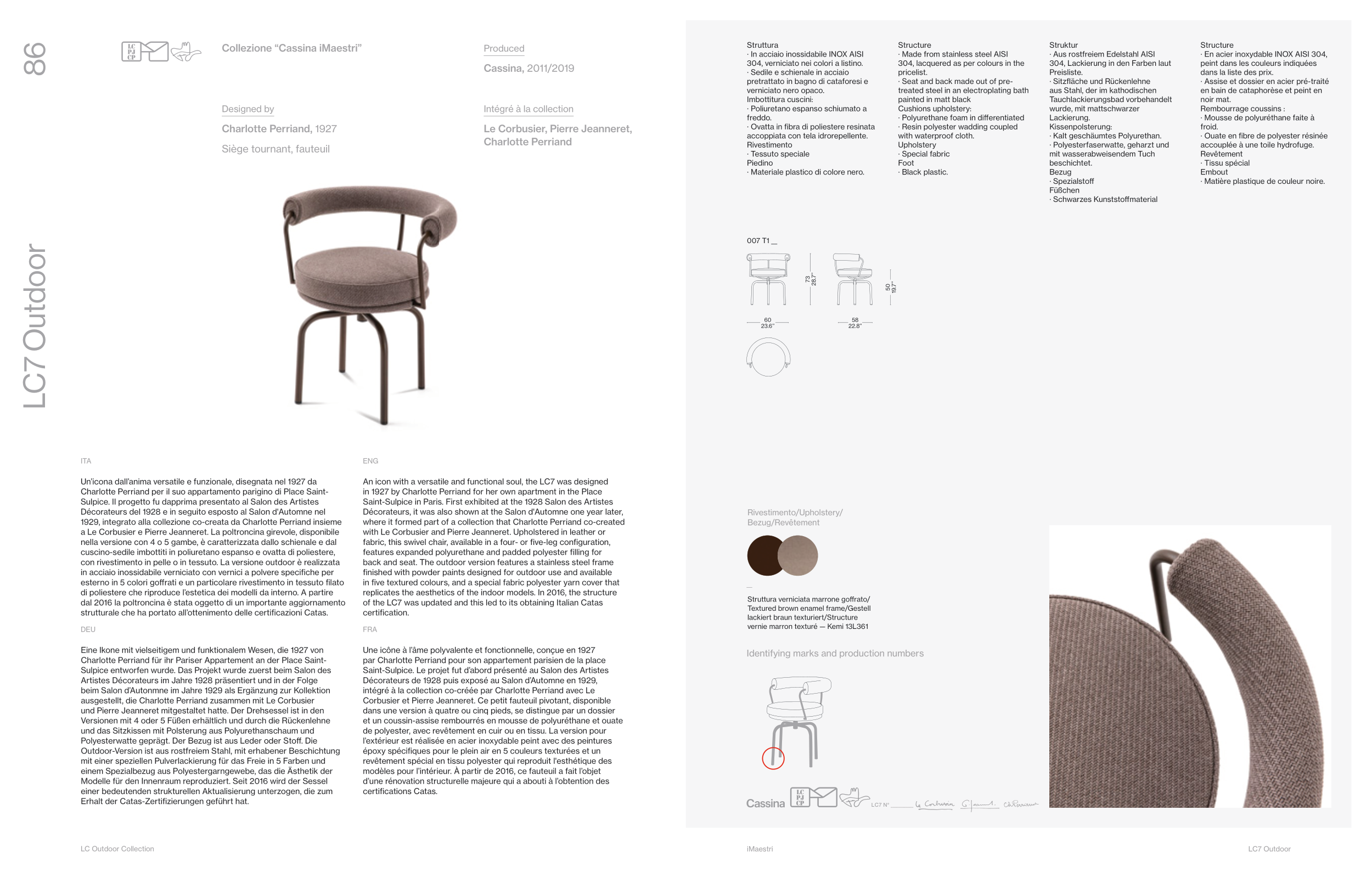LC7 Outdoor
Un’icona dall’anima versatile e funzionale, disegnata nel 1927 da
Charlotte Perriand per il suo appartamento parigino di Place Saint-
Sulpice. Il progetto fu dapprima presentato al Salon des Artistes
Décorateurs del 1928 e in seguito esposto al Salon d'Automne nel
1929, integrato alla collezione co-creata da Charlotte Perriand insieme
a Le Corbusier e Pierre Jeanneret. La poltroncina girevole, disponibile
nella versione con 4 o 5 gambe, è caratterizzata dallo schienale e dal
cuscino-sedile imbottiti in poliuretano espanso e ovatta di poliestere,
con rivestimento in pelle o in tessuto. La versione outdoor è realizzata
in acciaio inossidabile verniciato con vernici a polvere specifi che per
esterno in 5 colori goff rati e un particolare rivestimento in tessuto fi lato
di poliestere che riproduce l’estetica dei modelli da interno. A partire
dal 2016 la poltroncina è stata oggetto di un importante aggiornamento
strutturale che ha portato all’ottenimento delle certifi cazioni Catas.
An icon with a versatile and functional soul, the LC7 was designed
in 1927 by Charlotte Perriand for her own apartment in the Place
Saint-Sulpice in Paris. First exhibited at the 1928 Salon des Artistes
Décorateurs, it was also shown at the Salon d'Automne one year later,
where it formed part of a collection that Charlotte Perriand co-created
with Le Corbusier and Pierre Jeanneret. Upholstered in leather or
fabric, this swivel chair, available in a four- or fi ve-leg confi guration,
features expanded polyurethane and padded polyester fi lling for
back and seat. The outdoor version features a stainless steel frame
fi nished with powder paints designed for outdoor use and available
in fi ve textured colours, and a special fabric polyester yarn cover that
replicates the aesthetics of the indoor models. In 2016, the structure
of the LC7 was updated and this led to its obtaining Italian Catas
certifi cation.
Eine Ikone mit vielseitigem und funktionalem Wesen, die 1927 von
Charlotte Perriand für ihr Pariser Appartement an der Place Saint-
Sulpice entworfen wurde. Das Projekt wurde zuerst beim Salon des
Artistes Décorateurs im Jahre 1928 präsentiert und in der Folge
beim Salon d’Autonmne im Jahre 1929 als Ergänzung zur Kollektion
ausgestellt, die Charlotte Perriand zusammen mit Le Corbusier
und Pierre Jeanneret mitgestaltet hatte. Der Drehsessel ist in den
Versionen mit 4 oder 5 Füßen erhältlich und durch die Rückenlehne
und das Sitzkissen mit Polsterung aus Polyurethanschaum und
Polyesterwatte geprägt. Der Bezug ist aus Leder oder Stoff . Die
Outdoor-Version ist aus rostfreiem Stahl, mit erhabener Beschichtung
mit einer speziellen Pulverlackierung für das Freie in 5 Farben und
einem Spezialbezug aus Polyestergarngewebe, das die Ästhetik der
Modelle für den Innenraum reproduziert. Seit 2016 wird der Sessel
einer bedeutenden strukturellen Aktualisierung unterzogen, die zum
Erhalt der Catas-Zertifi zierungen geführt hat.
Une icône à l’âme polyvalente et fonctionnelle, conçue en 1927
par Charlotte Perriand pour son appartement parisien de la place
Saint-Sulpice. Le projet fut d’abord présenté au Salon des Artistes
Décorateurs de 1928 puis exposé au Salon d’Automne en 1929,
intégré à la collection co-créée par Charlotte Perriand avec Le
Corbusier et Pierre Jeanneret. Ce petit fauteuil pivotant, disponible
dans une version à quatre ou cinq pieds, se distingue par un dossier
et un coussin-assise rembourrés en mousse de polyuréthane et ouate
de polyester, avec revêtement en cuir ou en tissu. La version pour
l’extérieur est réalisée en acier inoxydable peint avec des peintures
époxy spécifi ques pour le plein air en 5 couleurs texturées et un
revêtement spécial en tissu polyester qui reproduit l'esthétique des
modèles pour l’intérieur. À partir de 2016, ce fauteuil a fait l’objet
d’une rénovation structurelle majeure qui a abouti à l’obtention des
certifi cations Catas.
ITA
ENG
DEU
FRA
Designed by
Charlotte Perriand, 1927
Intégré à la collection
Le Corbusier, Pierre Jeanneret,
Charlotte Perriand
Produced
Cassina, 2011/2019
Collezione “Cassina iMaestri”
Siège tournant, fauteuil
LC7 N° ____________
Identifying marks and production numbers
60
23.6’’
58
22.8’’
73
28.7’’
50
19.7’’
Struttura
· In acciaio inossidabile INOX AISI
304, verniciato nei colori a listino.
· Sedile e schienale in acciaio
pretrattato in bagno di cataforesi e
verniciato nero opaco.
Imbottitura cuscini:
· Poliuretano espanso schiumato a
freddo.
· Ovatta in fi bra di poliestere resinata
accoppiata con tela idrorepellente.
Rivestimento
· Tessuto speciale
Piedino
· Materiale plastico di colore nero.
Struktur
· Aus rostfreiem Edelstahl AISI
304, Lackierung in den Farben laut
Preisliste.
· Sitzfl äche und Rückenlehne
aus Stahl, der im kathodischen
Tauchlackierungsbad vorbehandelt
wurde, mit mattschwarzer
Lackierung.
Kissenpolsterung:
· Kalt geschäumtes Polyurethan.
· Polyesterfaserwatte, geharzt und
mit wasserabweisendem Tuch
beschichtet.
Bezug
· Spezialstoff
Füßchen
· Schwarzes Kunststoff material
Structure
· Made from stainless steel AISI
304, lacquered as per colours in the
pricelist.
· Seat and back made out of pre-
treated steel in an electroplating bath
painted in matt black
Cushions upholstery:
· Polyurethane foam in diff erentiated
· Resin polyester wadding coupled
with waterproof cloth.
Upholstery
· Special fabric
Foot
· Black plastic.
Structure
· En acier inoxydable INOX AISI 304,
peint dans les couleurs indiquées
dans la liste des prix.
· Assise et dossier en acier pré-traité
en bain de cataphorèse et peint en
noir mat.
Rembourrage coussins :
· Mousse de polyuréthane faite à
froid.
· Ouate en fi bre de polyester résinée
accouplée à une toile hydrofuge.
Revêtement
· Tissu spécial
Embout
· Matière plastique de couleur noire.
007 T1 __
Struttura verniciata marrone goff rato/
Textured brown enamel frame/Gestell
lackiert braun texturiert/Structure
vernie marron texturé — Kemi 13L361
Rivestimento/Upholstery/
Bezug/Revêtement
86
LC7 Outdoor
iMaestri
LC Outdoor Collection


